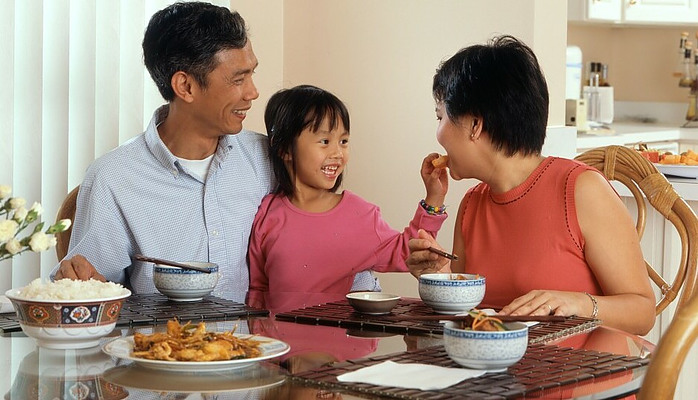Mindful Eating As A Family: Healthy Relationships With Food
 Can we do mindful eating as a family?!!!
Can we do mindful eating as a family?!!!
Mindful eating is an approach that involves fully attending to the experience of eating and savouring each bite. It’s about embracing food as more than just fuel but as a source of pleasure, nourishment, and togetherness. When I think about families gathering at the dinner table, I see an opportunity for more than just eating; it’s a chance to connect, communicate, and create lasting bonds.
Introducing mindful eating to the family setting can serve as a powerful catalyst in reshaping interactions with food. It can help every member, from the youngest to the oldest, attune to their bodies’ hunger signals and make more intentional choices about what, when, and how they eat.
For children, cultivating mindfulness during meals can lay the groundwork for a lifelong positive relationship with food. It can encourage them to appreciate the flavours, textures, and nourishment their meals provide. Parents have the dual benefit of setting an example and cementing their own healthy habits, which often ripple out to influence the entire family.
In the next part of this article, I’ll dive into the concrete benefits that mindful eating brings to both children and parents. You’ll see that, far from a fleeting trend, this approach can be the cornerstone of a happy, healthy home.
The Benefits of Mindful Eating in Children and Parents
Introducing mindful eating into your family’s routine does more than just change how you consume a meal; it lays the groundwork for lifelong healthy eating habits. This approach can be especially transformative for children, as it teaches them to pay attention to their hunger and fullness signals, fostering a balanced and positive attitude toward food. By practicing mindful eating, parents model behaviour that helps kids understand the importance of nourishment over mindless munching.
The shared experience of eating mindfully strengthens family bonds, too. When you set aside time to enjoy meals together, without the interruptions of phones or televisions, you create an environment ripe for conversation and connection. These moments allow parents and children to interact, share their day, and build trust over the simple act of dining together.
There’s also a profound joy that can be discovered in savouring the flavours, textures, and aromas of food when you eat mindfully. It encourages everyone at the table to appreciate the journey that food takes from farm to plate, and it can foster a sense of gratitude for the hands that prepared it. This appreciation can lead to wiser food choices, as the family becomes more interested in quality and the origins of their meals.
Mindful eating challenges the eat-and-run mentality that often leads to overeating or stress-related eating patterns. By slowing down, families can tune into their bodies’ actual needs, potentially reducing incidents of binge eating and emotional snacking. This practice supports not just physical health but emotional well-being, as it allows individuals to respond to emotional cues without turning to food as a crutch.
Practical Strategies for Promoting Mindful Eating at Home
I understand that shifting to mindful eating is more than a simple dietary change; it’s about enhancing the connection to food. To do this effectively, you need actionable strategies that can be incorporated into your daily routine. Here’s how to apply these strategies in your own kitchen.
Start by establishing family cooking nights. These aren’t just opportunities to cook together; they’re moments for you and your family to learn about ingredients, discuss their health benefits, and build culinary skills. This shared experience promotes understanding and respect for the food on your plates.
Mealtime rituals are also powerful. Beginning each meal with a moment of silence or expressing gratitude can set a purposeful tone. It encourages everyone to slow down and fully engage with their meal, fostering an atmosphere of appreciation and mindfulness.
Paying attention to hunger and fullness cues is key. Teach your children to recognize when they’re truly hungry and when they might be eating out of boredom or emotion. It’s a skill that will serve them well beyond the dining table.
Lastly, reduce technological distractions. Encourage your family to unplug from phones, TVs, and other devices during meals. This simple act can dramatically increase the quality of your interactions and keep everyone’s focus on the present moment.
Overcoming Challenges and Making Mindful Eating a Lasting Habit
Mindful eating with family isn’t a one-size-fits-all solution; it’s a personal journey that comes with its unique set of hurdles. However, overcoming these obstacles can make the process genuinely rewarding. Sometimes, family members might show resistance or find it hard to adapt to new routines. It’s essential to address their concerns with empathy, explaining the long-term benefits for their health and well-being.

Consistency is key when integrating new practices into your family’s life. Mindful eating habits take time to establish, so don’t get discouraged by occasional setbacks. Even if some meals aren’t as focused or quiet as others, what matters is the commitment to trying again at the next meal. Remember that change is a gradual process and persistence will pay off.
Here is my post about Healthy eating for children if you would like to read.
Every family’s routine is different and mindfulness should complement your lifestyle, not complicate it. For some, this may mean shorter, more focused mealtimes during the week with longer, leisurely dinners on the weekend. For others, it might involve silent gratitude before a meal or mindful eating exercises tailored to young children.
Patience and celebration go hand in hand on the path to lasting mindful eating habits. Understand that everyone progresses at their own pace and remember to acknowledge even the slightest positive change. Celebrate these moments—they are the building blocks of a healthier, more mindful relationship with food in your family.
Thank you for taking the time to join me in mindful family meal moments. Your presence is appreciated, and I invite you to share your thoughts and experiences during these times. Feel free to express your opinions and let me know how these family meals make you feel. Your insights contribute to the shared experience, fostering a sense of connection and understanding among us.
Cheers!








Hi Ela,
I found your “Mindful Eating As A Family” post to be delightful and informative read! It’s clear how this approach can strengthen family bonds and promote healthier eating habits. However, I couldn’t help but notice that some of the images in the post seem a bit distorted. Perhaps they are trying to stretch to fit the mindful eating concept, literally! On a more serious note, I’m curious about how families with picky eaters can integrate mindful eating practices. Is there a way to gently nudge kids towards healthier choices without turning mealtime into a battlefield?
Thank you for your work and sharing this valuable information!
Warm regards,
Makhsud
Hello Makhsud . Thank you for your comment! yeah that images maybe trying to do something lol. In my post healthy eating for children I widely explained and made some very practical examples for children if you would like to read. About picky eaters ,well being picky is not a bad thing actually is enough to practice eating more mindfully and more healthy and it is absolutely not a fast approach , it takes patience and time to gradually change our habbit for better. Cheers!
Healthy relationships with food are something I am always trying to learn more about. You will find me surfing the internet regularly for articles on this topic.
Parents should set good examples for their children by eating healthy. This will help the children to live a healthy childhood leading into adulthood.
I loved your mindful strategies section with such valuable information. Your section on overcoming challenges answered a lot of my questions.
Do you have any good resources that I could check out to get started on the right foot?
Jeff
Hello Jeff and thank you for your comment, Well said about setting good examples for children I totally agree with that . For little more hints maybe you check my post https://elevateeating.com/what-is-healthy-eating-for-children/
Cheers !
I love the idea of mindful eating and involving your whole family in the process, from preparing a meal together to sitting down to enjoy the flavors and appreciate the food as you eat it slowly and enjoyably.
Not only will this teach your children good habits that they can take with them for a lifetime, but will also remind you that you need to slow down when you eat and not rush to get all the food on your plate finished. In this way hopefully you will not be tempted to eat to much or have another helping.
What an enlightening read, Ela! Your blog beautifully captures the essence of mindful eating as a family practice. As someone who has embraced this approach, I couldn’t agree more with your sentiments.
Introducing mindfulness into family meals has been transformative for us. It’s not just about the food on our plates; it’s about the connections we foster and the values we instill in our children. By slowing down and savoring each bite, we’ve discovered a deeper appreciation for the nourishment food provides and the joy of sharing these moments together.
Your practical strategies offer actionable steps for anyone looking to integrate mindful eating into their family routine. From cooking nights to mealtime rituals, each suggestion resonates with the idea of cultivating a mindful relationship with food.
Overcoming challenges on this journey is indeed part of the process, but your reminder to stay consistent and celebrate even small victories is truly uplifting. It’s about progress, not perfection, and your words inspire us to keep moving forward.
Thank you for sharing your insights and encouraging us to embrace mindful family meal moments. I look forward to implementing more of these practices and continuing to nourish not just our bodies, but our souls as well. Cheers to mindful eating and the connections it brings!